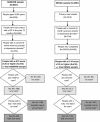Perceived need for mental health care and barriers to care in the Netherlands and Australia
- PMID: 20686887
- PMCID: PMC3173635
- DOI: 10.1007/s00127-010-0266-3
Perceived need for mental health care and barriers to care in the Netherlands and Australia
Abstract
Purpose: This study of Australian and Dutch people with anxiety or depressive disorder aims to examine people's perceived needs and barriers to care, and to identify possible similarities and differences.
Methods: Data from the Australian National Survey of Mental Health and Well-Being and the Netherlands Study of Depression and Anxiety were combined into one data set. The Perceived Need for Care Questionnaire was taken in both studies. Logistic regression analyses were performed to check if similarities or differences between Australia and the Netherlands could be observed.
Results: In both countries, a large proportion had unfulfilled needs and self-reliance was the most frequently named barrier to receive care. People from the Australian sample (N = 372) were more likely to perceive a need for medication (OR 1.8; 95% CI 1.3-2.5), counselling (OR 1.4; 95% CI 1.0-2.0) and practical support (OR 1.8; 95% CI 1.2-2.7), and people's overall needs in Australia were more often fully met compared with those of the Dutch sample (N = 610). Australians were more often pessimistic about the helpfulness of medication (OR 3.8; 95% CI 1.4-10.7) and skills training (OR 3.0; 95% CI 1.1-8.2) and reported more often financial barriers for not having received (enough) information (OR 2.4; 95% CI 1.1-5.5) or counselling (OR 5.9; 95% CI 2.9-11.9).
Conclusions: In both countries, the vast majority of mental health care needs are not fulfilled. Solutions could be found in improving professionals' skills or better collaboration. Possible explanations for the found differences in perceived need and barriers to care are discussed; these illustrate the value of examining perceived need across nations and suggest substantial commonalities of experience across the two countries.
Figures


Similar articles
-
Perceived need for mental health care: findings from the 2007 Australian Survey of Mental Health and Wellbeing.Aust N Z J Psychiatry. 2009 Jul;43(7):624-34. doi: 10.1080/00048670902970866. Aust N Z J Psychiatry. 2009. PMID: 19530019
-
Perceived need and barriers to adolescent mental health care: agreement between adolescents and their parents.Epidemiol Psychiatr Sci. 2019 Sep 20;29:e60. doi: 10.1017/S2045796019000568. Epidemiol Psychiatr Sci. 2019. PMID: 31538555 Free PMC article.
-
Perceived needs for mental health care and barriers to treatment across age groups.Aging Ment Health. 2017 Oct;21(10):1072-1078. doi: 10.1080/13607863.2016.1193121. Epub 2016 Jun 3. Aging Ment Health. 2017. PMID: 27261055
-
Perceived need for mental health care among non-western labour migrants.Soc Psychiatry Psychiatr Epidemiol. 2009 Mar;44(3):208-16. doi: 10.1007/s00127-008-0418-x. Epub 2008 Sep 11. Soc Psychiatry Psychiatr Epidemiol. 2009. PMID: 18787746
-
Primary care patients with anxiety and depression: need for care from the patient's perspective.J Affect Disord. 2009 Dec;119(1-3):163-71. doi: 10.1016/j.jad.2009.03.019. Epub 2009 May 5. J Affect Disord. 2009. PMID: 19419771
Cited by
-
A Latent Class Analysis of Perceived Barriers to Help-seeking Among People with Alcohol Use Problems Presenting for Telephone-delivered Treatment.Alcohol Alcohol. 2023 Jan 9;58(1):68-75. doi: 10.1093/alcalc/agac063. Alcohol Alcohol. 2023. PMID: 36448844 Free PMC article. Clinical Trial.
-
Universal Coverage without Universal Access: Institutional Barriers to Health Care among Women Sex Workers in Vancouver, Canada.PLoS One. 2016 May 16;11(5):e0155828. doi: 10.1371/journal.pone.0155828. eCollection 2016. PLoS One. 2016. PMID: 27182736 Free PMC article.
-
Development and Validation of Prediction Models for Perceived and Unmet Mental Health Needs in the Canadian General Population: Model-Based Synthetic Estimation Study.JMIR Public Health Surveill. 2025 Feb 19;11:e66056. doi: 10.2196/66056. JMIR Public Health Surveill. 2025. PMID: 39969822 Free PMC article.
-
Stigma, Discrimination and Other Social-Structural Factors Associated with Barriers to Counselling or Therapy among Women Living with HIV Who have Experienced Violence in Metro Vancouver, Canada.AIDS Behav. 2024 Nov;28(11):3919-3928. doi: 10.1007/s10461-024-04456-2. Epub 2024 Sep 23. AIDS Behav. 2024. PMID: 39307899
-
Factors associated with reported service use for mental health problems by residents of rural and remote communities: cross-sectional findings from a baseline survey.BMC Health Serv Res. 2013 Apr 30;13:157. doi: 10.1186/1472-6963-13-157. BMC Health Serv Res. 2013. PMID: 23631501 Free PMC article.
References
-
- Australian Bureau of Statistics (ABS) (2007) Technical manual: National Survey of Mental Health and Wellbeing, confidentialised unit record files. ABS, Australia
Publication types
MeSH terms
LinkOut - more resources
Full Text Sources
Miscellaneous

